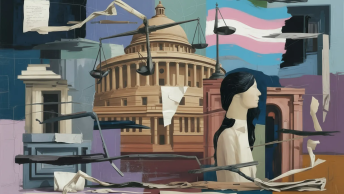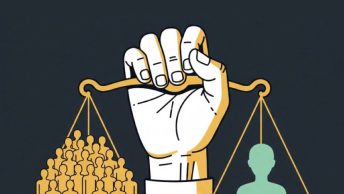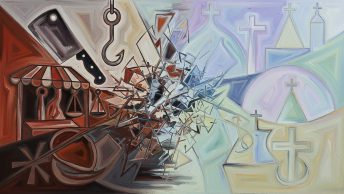The Supreme Court judgment in Navtej Singh Johar is nothing less than a prism for the bipolarity of sexuality dispersing it into the eight colors of pride. The judgment bases its reasoning on constitutional morality, which although subjective, emulates the constitutionalism of societal values, majoritarian morality, and religious rigidity. Rohinton Fali Nariman, J. in his judgment has highlighted how sexual inclination, which is a part of the expression of choice and dignity, cannot be suppressed by majoritarian perception.
Despite this progressive judgment, the Transgender Community has been facing increasing violence within a few weeks of the landmark ruling. This makes us question the position of the Supreme Court in power matrix of a democracy. Is it merely an institution to create change rather than sustain it? What are the reasons because of which it falls short of resonating with social opinion?
The authors argue that whilst the judgment is tool for social change, it may be unable to function as an effective measure for social acceptance. The LBGTQIA+ social movement in the United Kingdom – a prominent example of social reform being achieved through continual public engagements and social movements – completely transformed the oppressed identity into a formally protected LGBTQIA+ identity by means of the legal system. The Navtej Johar judgment, although a milestone, remains inadequate in tackling the historically consolidated bias against the LGBTIQA+ community. The reasons being:
- Legal Realism: Sonia Sotomayor, Associate Judge of U.S. Supreme Court once remarked that “a wise Latina woman with the richness of her experiences would more often than not reach a better conclusion than a white male who hasn’t lived that life.” Her idea being that ethnicity and sex of a judge may and will make a difference in a judge’s opinion. Jurisprudentially this thought was first given by the school of American Legal Realism. It challenges the prevailing view that judges are rational decision-makers, who apply only legal rules found in law books to the facts of the case and that rather judges follow an intuitive process to reach their conclusions which they only later rationalize with deliberative reasoning.
This legal realism exists very well in India where the general perception of the populists is to consider judges as having ground knowledge limited to Lutyens. The judges of Supreme Court are generally considered to be coming from the elite population having ideas oblivious of ground realities. The judgments of the Supreme Court consist of such English terms that they give reminiscence of Victorian age to a layman and can leave even Daedalian perplexed. This creates a language barrier between the Court and the masses. Least the perception of judges, the neutrality of the art and architecture of the apex court has now been questioned. This creates a gap between public perception and the judges reasoning for such societal change. Most of the population is left with daily newspapers as source of their legal information where there is absence of any legal reasoning, thus creating a further gap.
- Popular Representation: Democratic theory has recently been marked by a “‘rediscovery’ of representation,” which came after several decades of intense focus on participation, and more lately on deliberation—two dimensions that seemed to offer brighter promises in terms of deepening of democracy. People in a democracy tend to trust more on representative institutions as they can express their mistrust through protests. Same is not true for non-representative Judicial institutions. Although the Indian Constitution permits the appointment of any lawyer of high ability to serve on the Supreme Court, the justices are almost always selected from senior sitting judges of the high courts of the state, with some mild effort in recent years at geographical representation. The distributive representation of the apex court has been often questioned with only one Dalit and eight women representatives in its history.
This being so there is a legal thought that indirect representative institutions, particularly by establishment of surveillance and vigilance institutions, has grown mistrust in them. Thus, non-representation of people in the court creates an additional, though mild, factor for non-identification of voice by people in the court.
- Inadequacy of Legal Precedents to create social change against LGBTQIA+ identity: Democratic participation and movements are fundamental in the effective enforcement of LGBTQIA+ rights in the society. The critique of the judgment, is that it fails to initiate a social change, emanates from the jurisprudential limitations of precedents as instruments of social reform. The infamous Eugen Ehlrich (1862-1922), one of the founders of the sociology of law distinguished ‘living law’ from the abstracted judicial understanding of law and expressed that ‘living law’ is a continuous outcome of social process. There are inherent limitations upon the Supreme Court precedents with regards to changing social behavior against the LGBTQIA+ community. Socio-political movements are the primary tools to stimulate a favorable socio-political environment for the LGBTQIA+ identity. Abstracted judicial principles of constitutionalism reflected in the Navtej Johar judgment, intended to protect the identities based on sexual orientation will not have a considerable impact upon a large section of the Indian society. Despite the apex court’s judgment, homophobic behaviors; discrimination; and societal attitudes shall still persist amidst the wider range of social arenas: workplace, housing, marriage, religion, social culture, health services, etc.
- State institutions to protect the LGBTQIA+ identities: The absence of State institutions empowered with legal authority to protect the LGBTQIA+ identities from discrimination, directs attention towards a dire need for civil rights protection. The intolerance and injustice faced by the LGBTQIA+ identities is not limited to merely decriminalization through S.377 of IPC, but extends beyond such criminalization to rampant discrimination faced by the LGBTQIA+ groups in every aspect of life. The Constitution of India guarantees formal equality and protection against discrimination on the basis of sexual orientation. However, there is no domestic legislation in place to protect their civil rights. Favorable social change and acceptance for the LGBTQIA+ community can be achieved only through empowering and entrusting the State institutions with the dual duty of enforcing equality and countering the discriminatory treatment meted out to the LGBTQIA+ identities by way of effective civil rights legislation and socio-political movements.
CONCLUSION:
The long-term challenges faced by the LGBTQIA+ community do not cease with the apex court’s judgment but rather the effective solution lies in socio-political movements which instil social change and create societal acceptance for the LGBTQIA+ community. The legislature will have to intervene ultimately to provide a comprehensive policy mechanism to ensure that these groups are not physically victimized, socially segregated and culturally stigmatized.
The shuttle of civil rights is ready for launch. The gravity of social non-acceptance stands strong, and the glorious space of liberty remains far off. It is for the Queer community to hustle and stand as a formidable force against the challenges that still loom large on the horizon.







